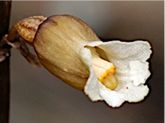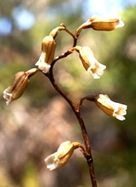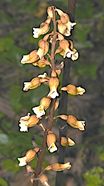Two species of Cinnamon Bells orchids, which you may see on your walks during the next couple of months, are Gastrodia procera Tall Cinnamon Bells, and G. sesamoides Cinnamon Bells.
Gastrodia, the genus name, means pot-bellied, and refers to the inflated base of the bell-like flowers; the species name procera means very tall, while sesamoides relates to its resemblance to the flowers of the genus Sesamum that produce sesame seeds.
The common name for these two species of orchids, Cinnamon Bells, depicts just how special these orchids are, with their cinnamon-brown, white-tipped, bell-shaped flowers, which emit a spicy, cinnamon scent.

Cinnamon Bells flower
Both species grow in the district, but neither is common. You are more likely to find G. sesamoides, which is quite widespread, growing in open forests and woodlands.
Gastrodia sesamoides grows to about 30 cm tall, and is characterised by its slender flower stem, which can bear up to 20 well-spaced flowers, but often there are just a few. The stem tip is bent over in the bud stage, and usually straightens as the flowers develop. The orchid is a self pollinating species.

Cinnamon Bells
Gastrodia procera is very rare in the district, as it usually grows in damper, Mountain Ash forest. However, it was seen growing abundantly at Moggs Creek in the early 1990’s. Since then, only a few plants have been observed there. The species is much stronger than G. sesamoides. Its robust flower stem grows to about 120 cm, bearing up to 70 flowers, crowded along the flower stem. The bud stem is always upright. The orchids are pollinated by native bees, as they visit the flowers to collect a pollen-like substance that is produced abundantly on the labellum.

Tall Cinnamon Bells
Both species are leafless. They are hemiparasitic, relying on some of the fungi in the soil for part of their nutrients. Their flowers are similar, although those of G. procera are, as you would expect, larger than those of G. sesamoides. The dorsal sepal, lateral sepals and petals are united to form a tube, with small, free tips. The labellum and column are hidden inside the bell-shaped flowers.
These two orchids grow from late spring to early summer, so you might just happen to see them in the next few months if you are walking in the district. A few flowering stems of G. sesamoides were observed during our recent Grevillea infecunda survey in the Otway Forest Park.

Cinnamon Bells bud
Gastrodia procera was observed in bud, near Forrest, when the Friends of Eastern Otways were there recently.

Tall Cinnamon Bells bud
You will find other orchids to admire during the summer months: Duck Orchids, Hyacinth Orchids, Horned Orchids, Large-tongue Orchids and Elbow Orchids.
Please let us know if you have any special observations. Photos and descriptions of all the orchids that grow in the Anglesea district are documented in Orchids of the Anglesea District available from Angair.
Additional reference: Mayfield, Enid, 2013 Flora of the Otway Plain & Ranges 1 CSIRO PUBLISHING
Photos are by M. & C. Rowan (G. procera), H. Schofield (G. procera Bud), and M. MacDonald